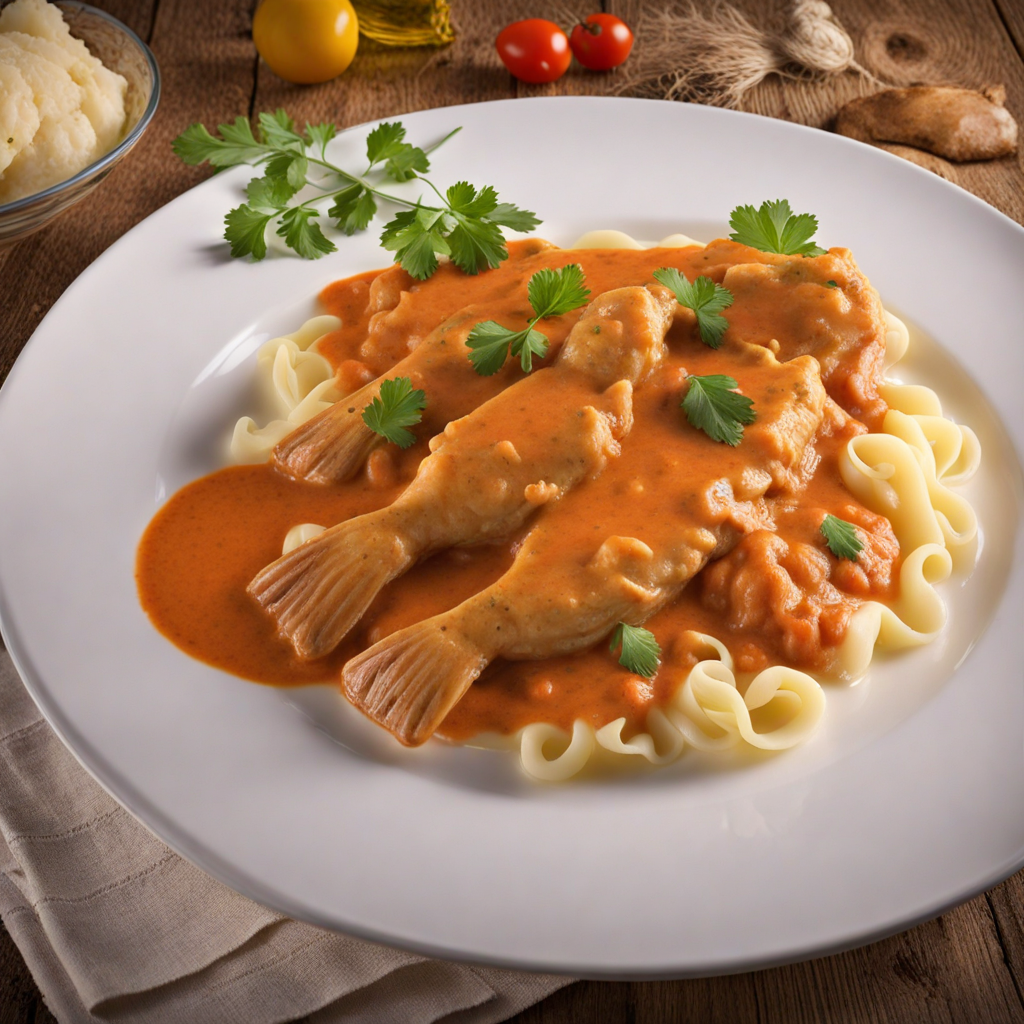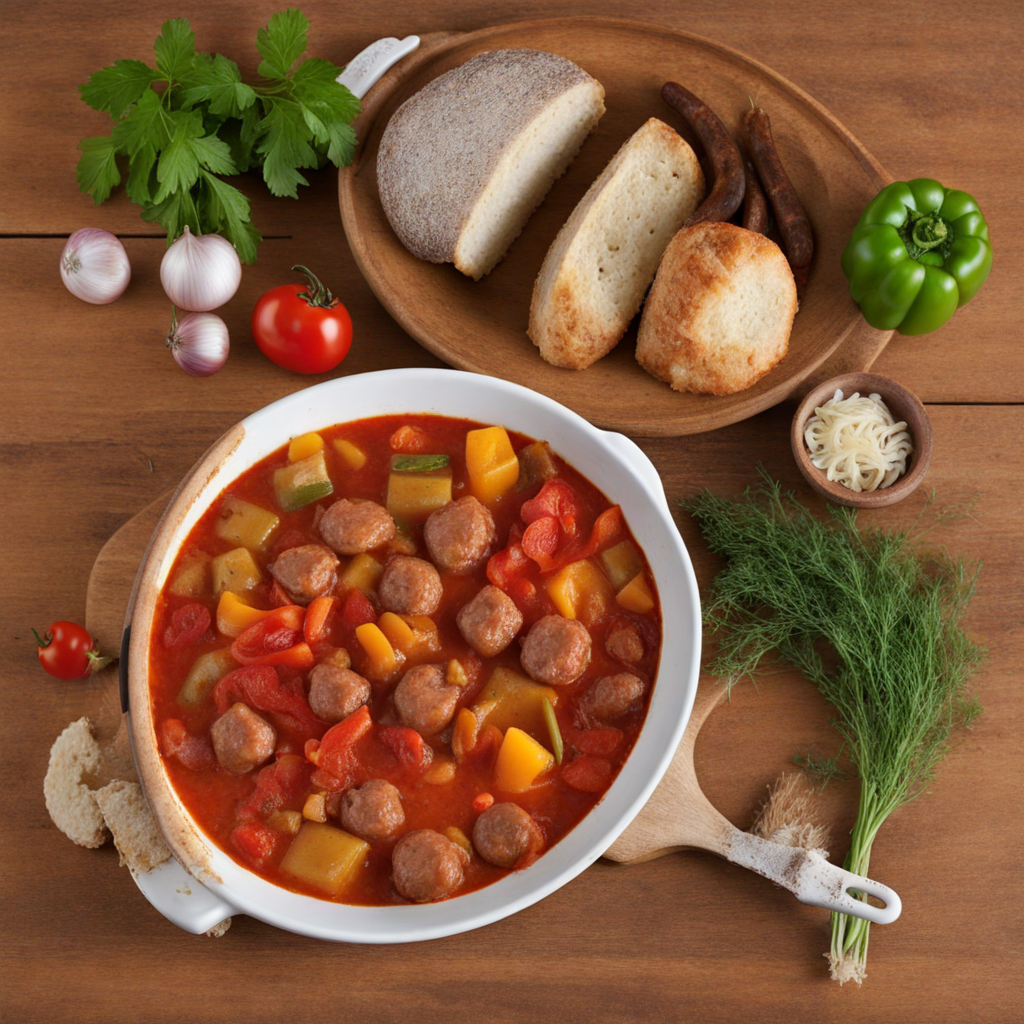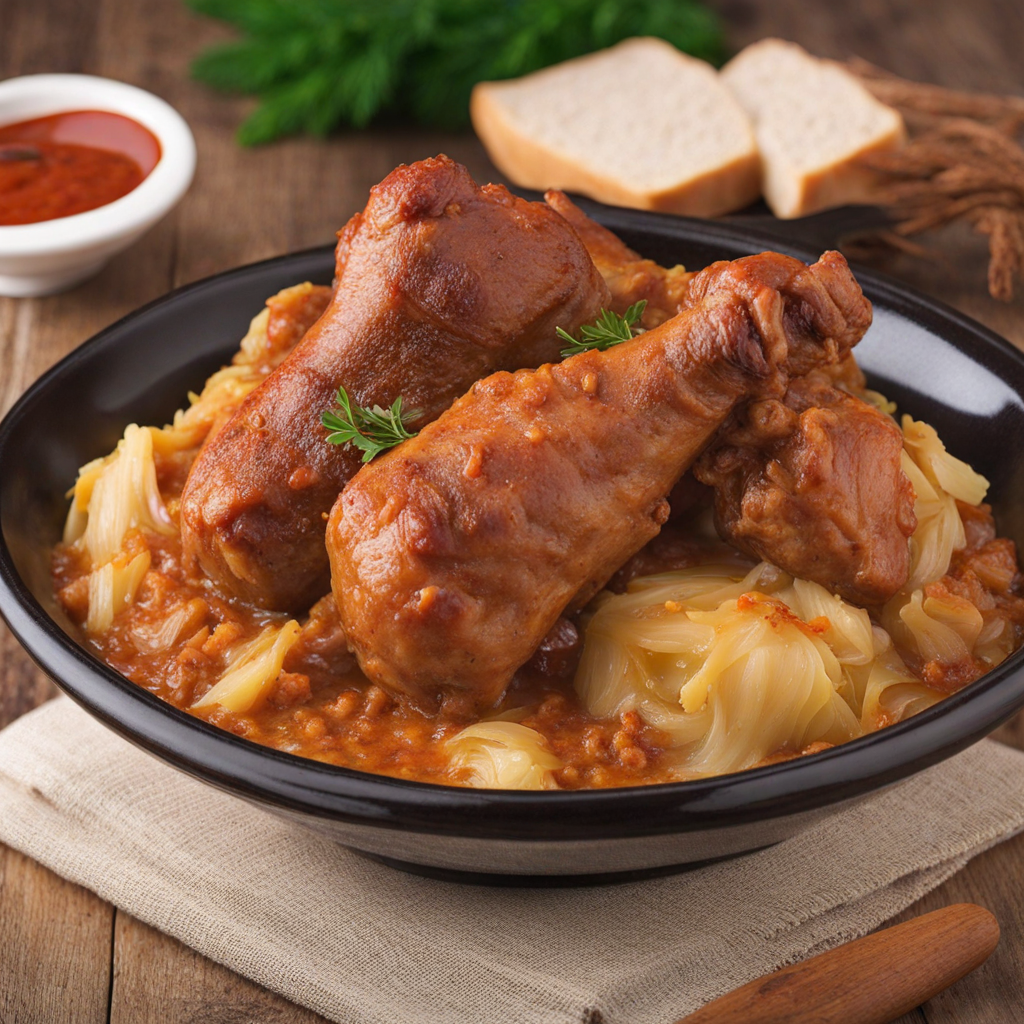Harcsapaprikás
Harcsapaprikás is a traditional Hungarian dish that showcases the rich culinary heritage of the country, particularly its love for paprika. This hearty stew features catfish, known locally as harcsa, which is prized for its firm, flaky texture and mild flavor. The fish is typically simmered in a vibrant sauce made from sautéed onions, sweet paprika, and sometimes a hint of hot paprika, creating a tantalizing balance of heat and sweetness. The dish is often enriched with tomatoes and bell peppers, which not only enhance the flavor but also contribute to the beautiful red hue that is characteristic of Hungarian cuisine. As the catfish cooks, it absorbs the aromatic spices and flavors of the sauce, resulting in a comforting dish that is both hearty and satisfying. The use of paprika, a staple in Hungarian cooking, elevates the dish, providing depth and complexity. The stew is often accompanied by a side of nokedli, a type of soft egg noodle, or fresh crusty bread, making it perfect for soaking up the delightful sauce. The combination of textures from the tender fish and the rich sauce creates an experience that is both indulgent and memorable. For those looking to explore a new taste, Harcsapaprikás offers a delicious dive into the world of Hungarian flavors. Each bite transports you to the heart of Hungary, where the warmth of spices and the freshness of the fish come together in perfect harmony. Whether enjoyed at a family gathering or in a cozy restaurant, this dish embodies the spirit of Hungarian hospitality and the joy of sharing a meal with loved ones.
How It Became This Dish
Harcsapaprikás: A Culinary Journey Through Hungary’s Heritage Harcsapaprikás, or catfish paprikash, is a beloved dish that encapsulates the essence of Hungarian cuisine. This unique dish showcases the rich culinary traditions of Hungary, blending the country's love for paprika with the flavors of freshwater fish, particularly catfish. With its roots deeply embedded in the cultural and historical landscape of Hungary, harcsapaprikás is not just food; it is a symbol of regional identity, a taste of tradition, and a celebration of local ingredients. Origins: Where It All Began The origins of harcsapaprikás can be traced back to the waterways of Hungary, where catfish, known as "harcsa," thrive in rivers and lakes such as the Danube and Tisza. These waterways have been vital to the sustenance and livelihoods of local communities for centuries. Fishing has long been a significant part of Hungarian culture, with catfish being a prized catch due to its firm texture and mild flavor. The dish itself is a variant of the traditional paprikash, a classic Hungarian preparation that typically features meat stewed in a rich paprika-based sauce. While the use of chicken or pork is more common in many paprikash recipes, harcsapaprikás represents a regional twist that highlights the availability of local fish. This adaptation can be seen as a reflection of Hungary's agricultural and environmental landscape, where fish became an essential protein source for many families. Cultural Significance: More Than Just a Meal Harcsapaprikás is more than just a dish; it is a cultural emblem of Hungary. Paprika, the spice that defines this meal, has a storied history in Hungary, having been introduced from the New World in the 16th century. Over time, it evolved into a cornerstone of Hungarian cuisine, symbolizing the country's agricultural resilience and culinary creativity. The dish is particularly popular in the southern regions of Hungary, especially around the Great Plain, where catfish are abundant. For many families, preparing harcsapaprikás is a cherished ritual, often served during gatherings and celebrations. It captures the spirit of Hungarian hospitality, as sharing a hearty, flavorful meal brings people together. In addition to its communal aspect, harcsapaprikás also holds significance in various festivals and culinary events across Hungary. Food festivals often showcase local specialties, and harcsapaprikás is a staple highlight, attracting both locals and tourists eager to experience authentic Hungarian flavors. Development Over Time: A Culinary Evolution As with many traditional dishes, harcsapaprikás has evolved over time, influenced by changes in culinary practices, regional variations, and modern tastes. In its simplest form, harcsapaprikás consists of catfish fillets cooked in a sauce made from onions, tomatoes, and, of course, paprika. However, as culinary trends have shifted, so too have the methods and ingredients used in preparing this dish. In earlier times, harcsapaprikás was likely prepared with minimal ingredients, relying heavily on the freshness of the catch. Today, variations abound, with many cooks incorporating additional ingredients such as bell peppers, garlic, and even sour cream to enrich the sauce. Some cooks may also experiment with different cooking techniques, like grilling or baking the catfish before adding it to the sauce, providing a smoky depth of flavor that complements the spice. Moreover, the dish has gained a place in contemporary Hungarian gastronomy, often featured in upscale restaurants that focus on modern interpretations of traditional fare. Chefs may infuse harcsapaprikás with international influences, showcasing the versatility of the dish while honoring its roots. For instance, fusion recipes may involve the use of exotic spices or alternative cooking methods, appealing to a broader audience that appreciates culinary innovation. Ingredients and Preparation: A Closer Look The preparation of harcsapaprikás is an art that emphasizes the quality and freshness of its ingredients. Fresh catfish is the star of the dish, valued for its tender flesh and ability to absorb flavors. The key ingredient, paprika, is often a high-quality, sweet Hungarian variety, which lends the dish its vibrant color and distinctive taste. The cooking process typically involves sautéing onions in lard or oil until they are soft and translucent. Paprika is then added to the onions, followed by diced tomatoes and, occasionally, bell peppers, creating a rich and aromatic base. The catfish is gently simmered in this sauce, allowing it to soak up the flavors while maintaining its delicate texture. The dish is often finished with a dollop of sour cream, adding a creamy richness that balances the heat of the paprika. Traditionally, harcsapaprikás is served with a side of nokedli (Hungarian dumplings) or a variety of crusty bread, perfect for soaking up the delicious sauce. This pairing not only enhances the dining experience but also reflects the Hungarian ethos of hearty, satisfying meals. Conclusion: A Dish for the Ages Harcsapaprikás is a dish that embodies the heart and soul of Hungarian cuisine. Its humble origins as a local fish dish have transformed into a celebrated culinary tradition that continues to evolve while honoring its historical roots. As Hungary navigates the complexities of modern gastronomy, harcsapaprikás remains a beloved staple, cherished by generations for its comforting flavors and cultural significance. Whether enjoyed at a family gathering, a bustling market, or a gourmet restaurant, harcsapaprikás serves as a reminder of the importance of local ingredients and culinary heritage. It is a dish that tells a story—a story of the land, the people, and the enduring love for food that transcends time and place.
You may like
Discover local flavors from Hungary







